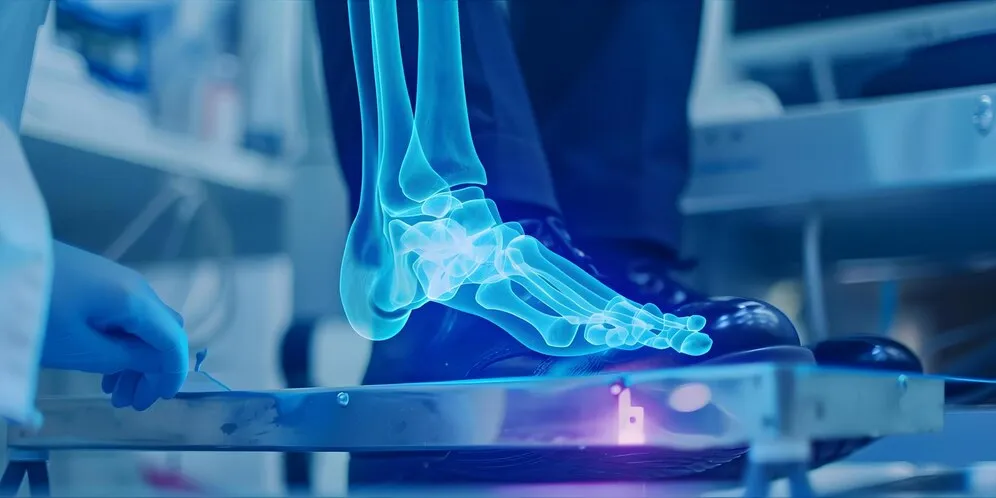Author: Minhal Abbas
23 June, 2025
Custom AI revolutionizes manufacturing by making plants safer places to work and cutting down on accidents. By developing and deploying custom AI solutions to industrial environments, organizations can identify hazardous areas in advance, continually monitor the equipment, and predict risk before incidents occur.
AI solutions are becoming a “game changer” for workplace safety with capabilities that never existed before, for predicting, preventing, and responding to potential incidents before they happen.
This blog explains how custom AI can help to keep workers safe in the manufacturing sector and prevent accidents. We also provide how Xorbix Technologies ensures staff are safe and plants are working efficiently by getting data, automation, and smarter decision-making.
Current State of Manufacturing Safety Challenges
The manufacturing sector has some specific safety challenges that are difficult to zero with conventional methodologies. According to the U.S. Bureau of Labor Statistics, every six seconds, a workplace injury and every 1.6 hours, a tragic death is related to many unfortunate workplace accidents. These numbers show how important it is to have new and creative safety solutions that go beyond just using regular safety gear and training.
Typical hazards for safety in the manufacturing industry are: Machine failure, Mistakes by humans, Chemical exposure issues. Current solutions are primarily reactive, and safety technologies can help reduce the number of accidents.
What is Custom AI and How Does It Transform Safety?
Custom AI development built for your organization alone to meet its safety needs and mitigate its specific risks. It enables you to develop customized systems that understand your particular manufacturing environment, machines, and workforce trends.
Key Components of Custom AI Safety Solutions:
Some of the most important factors of custom AI solutions are given below:
- Predictive Analytics: Machine Learning algorithms evaluate historical results, operational metrics, and environmental variables to forecast future safety incidents before they occur.
- Computer Vision Systems: Cameras and sensors linked by AI routinely scan work zones, picking up unsafe behaviors, equipment malfunctioning, and environmental hazards in an instant.
- Natural Language Processing: AI applications can process safety reports, maintenance logs, and incident reports to find correlations and suggest preventive measures.
- Internet of Things Integration: Throughout the facility, connected sensors produce real-time streams of data that AI systems can use to maintain a robust awareness of the current situation.

How Does Custom AI Reduce Workplace Hazards?
End-user companies have seen impressive benefits from using customized AI in manufacturing. AI-enabled applications can solve the industry’s safety challenges in several ways:
1. Equipment Monitoring and Predictive Maintenance
Custom AI solutions are great for processing large amounts of sensor data from factory machinery. These solutions track vibrations, temperature swings, pressure shifts, and other signs of equipment breaking down. AI can predict equipment failure before it happens by analyzing data patterns of the equipment, thereby avoiding accidents due to faulty equipment.
You can navigate our case study “Modernizing Heavy Equipment Operations with a Multi‑Platform Manuals & Documentation Tool”. In this study, Xorbix custom AI tools reduce downtime and streamline maintenance for heavy manufacturing products.
2. Personal Protective Equipment (PPE) Compliance
AI-based safety systems can verify by themselves whether workers are wearing hard hats, safety glasses, gloves, or protective suits. Computer vision AI can track worker behavior and tell if safety protocols are being violated, offering instant feedback and opportunities for coaching.
3. Ergonomic Risk Assessment
In milliseconds, AI can recognize hazardous conditions that are much too quick for the human eye to perceive. This early warning leads directly to proactive safeguards and automatic safety protocols. Generative AI algorithms can be used to assess worker movements and postures to determine potential ergonomic hazards that may manifest as musculoskeletal disorders. These systems give data or feedback instantly so workers can practice safe postures.
4. Chemical Safety and Environmental Monitoring
Air quality, temperature, noise level, and other environmental factors that could pose safety risks. Custom-AI solutions can always keep an eye on the quality of air and exposure to chemicals, making the call to open ventilation systems or evacuate when conditions become unsafe.
Check our case study “Creating an LLM Testing Solution Accelerator for Databricks,” on which Xorbix Technologies focuses on custom AI in factory workflows and demonstrates quality control and deployment best practices in manufacturing processes.
Strategic Advantage of Custom AI Development
This is not to say that generic safety software doesn’t have its place, but that custom AI development offers manufacturing organizations several strategic benefits:
- Industry-Specific Expertise: Your custom AI solutions are developed with a deep understanding of your unique manufacturing processes, regulations, and safety challenges.
- Seamless Integration: Our AI systems integrate seamlessly with existing manufacturing execution systems (MES), ERP systems, and other business software.
- Scalable Architecture: AI scales with your business as it expands into new sites, equipment, and safety needs.
- Competitive Differentiation: Companies that deliver robust AI-enabled safety systems also often benefit from increased employee retention, lowered insurance costs, and improved operational efficiency.
Implementation Custom AI Strategy: From Idea to Impact
Effectively deploying customized AI safety solutions is not a purely technical exercise, but also requires cultural and operational alignment.
Step 1: Safety Review and AI Plan
You can only manage what you measure. In this phase, our AI experts collaborate closely with your safety team to pinpoint the highest-impact sites for AI deployment. With AI Strategy services from Xorbix, we create full-fledged plans for deploying AI, guaranteeing safety initiatives with overall business goals.
Step 2: Demonstration and Validation
Before deployment at scale, AI safety implementations start with specific, focused proofs of concept that show the value and possibility. Pilot programs help companies test their AI solutions in a controlled setting, taking into consideration actual user feedback.
Step 3: Integrate and Deploy
AI safety solutions need to fit well into existing systems. These interface with manufacturing execution systems, safety management platforms, and communication systems to provide a more robust response.
Step 4: Ongoing Enhancement and Optimization
AI models continue to learn based on both new data and feedback. Continuous re-performance and review of system performance, safety performance, and user feedback will enable the fine-tuning and further development of AI capabilities.
Addressing Common Implementation Issues
During the implementation of Custom AI, some of the common challenges are given below:
Data Quality and Availability
AI safety systems can be effective only if high-quality data are derived from various sources. For many organizations, this requires upgrading sensors, refining data capture processes, and setting up solid policies around data governance to support AI projects.
Change Management & User Adoption
Change management is needed when implementing AI safety systems to ensure worker buy-in and adoption. Training courses, effective communication about the benefits, and phased implementation can facilitate successful adoption overall.
Integration Complexity
Production environments can be heterogeneous, and a legacy-based custom AI development serves to assist with these obstacles. Developing systems that work through pre-existing bottlenecks while affording routes for subsequent modernisation.
Future Trends of AI-Driven Manufacturing Safety
AI technology is rapidly opening doors for opportunities to increase safety in manufacturing:
- Edge Computing: High-level processing at the device level allows for faster response time and decreased reliance on connectivity.
- Digital Twins: Manufacturing plants and facilities in virtual forms, for creating safety scenarios and optimizing, without any disturbance.
- Augmented Reality Integration: AR in safety approach companies, such as RealWear, uses AI-powered AR systems to ensure workers are given up-to-date safety information and tips right on location where the work is performed, right within the worker’s eyeline.
- Advanced Predictive Analytics: Machine learning models advance in their ability to predict challenging safety situations and prescribe preventative actions.
Taking Action with Xorbix: Your Next Steps
The real question isn’t whether AI can make manufacturing safer. The real question is how soon your company can start on the path to those benefits with the intelligent use of AI. Now, Xorbix Technologies has a plan to use AI to keep people safer; they should be considering:
- Safety Review: Review existing safety methods and map out high-impact opportunities for AI applications.
- Strategic planning: Establish a clear plan for deploying AI to meet business and safety goals.
- Pilot Program Development: Begin with strong proof-of-concept projects that prove value and establish organizational momentum.
- Partner Selection: Engage with AI development teams with proven experience in manufacturing and insight into safety needs.
Xorbix AI Tech Solutions has supported many manufacturing companies in deploying customized AI solutions and providing safety enhancements and business value. From strategy to full implementation and continuous optimization, we cover all corners of AI development here.
Conclusion
Yes, custom AI can significantly improve workplace safety and prevent accidents in manufacturing. Custom AI offers a game-changing opportunity for manufacturing facilities to traditional reactive safety methodologies. Custom AI is preventive, proactive expert safety management. The stage is set for the technology to ease unsafe workplace behaviors, protect workers, and enhance automation capabilities all at once.
FAQ
Q 1. Will AI replace human safety inspectors?
No Custom AI enhances human expertise by taking on repetitive monitoring, allowing people to focus on high-value work.
Q 2. How does AI handle data privacy?
Xorbix builds edge processing, encrypted data lanes, and strict role-based access into every project, so your video and sensor info stays private.
Q 3. What kind of infrastructure is needed?
IP cameras you already have, on-prem GPUs or cloud instances, and an API to your EHS system.
To explore more about Custom AI in the manufacturing sector, visit our interesting guides:




